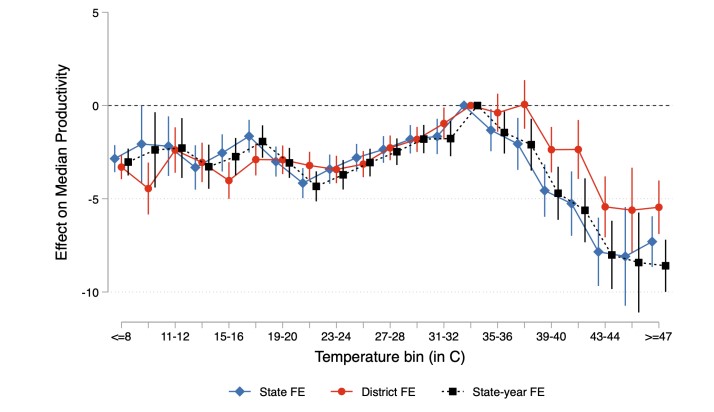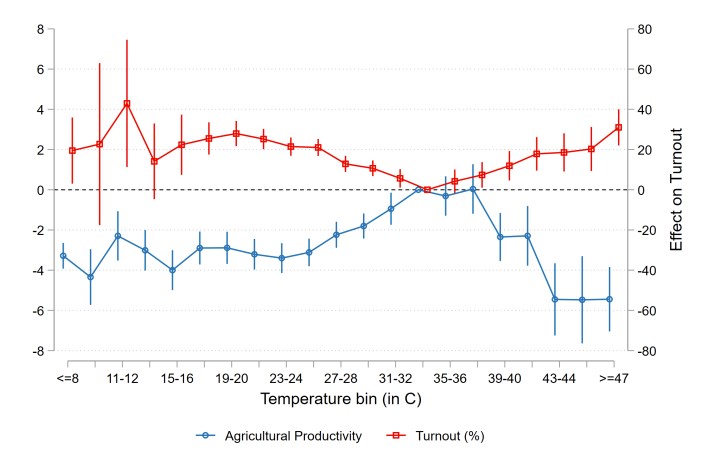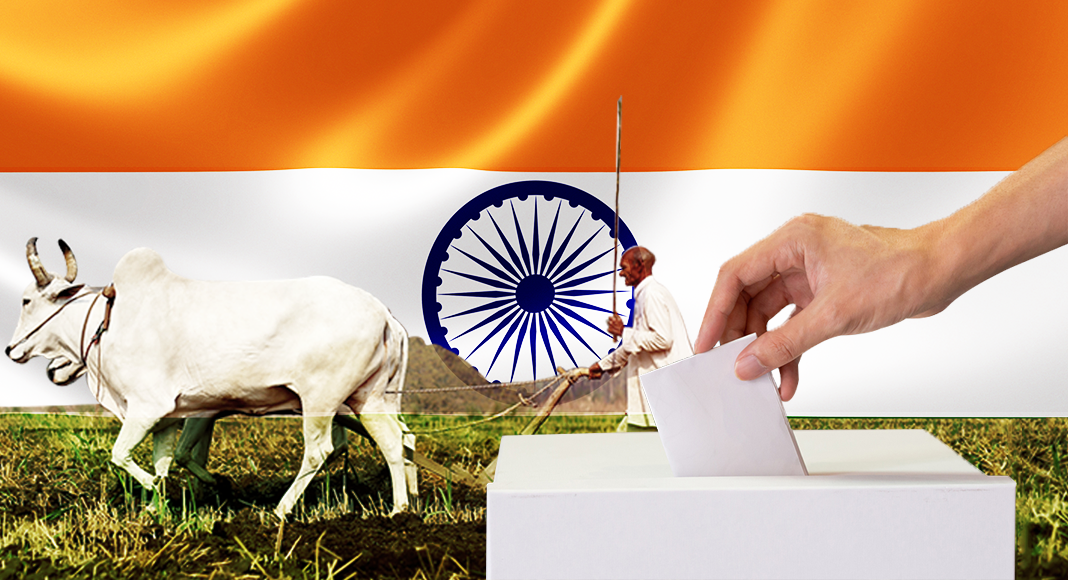Farmers in low-income countries have multiple channels through which they respond to climate change. Some switch to growing more heat-resilient crops or crops that require less water. Others migrate or leave agriculture altogether. In new research, Amrit Amirapu, Irma Clots-Figueras, and Juan Pablo Rud find that temperature shocks to agricultural production in India increase voter turnout in rural areas and push rural voters to elect candidates who are on average poorer, less tainted by corruption, and have a background in agriculture.
The earth’s climate is warming, bringing with it an increase in the frequency and severity of extreme weather events, such as droughts, floods and periods of extreme heat. Rural inhabitants of low-income countries are particularly vulnerable to such shocks due to their reliance on traditional agriculture for employment and income and their relative lack of access to financial markets, insurance markets, and other institutions that reduce exposure to risks and help people cope with the aftermath of shocks.
A growing academic literature documents how farmers in low-income countries respond to the harmful effects of extreme heat on agricultural production. In many cases, farmers can change the way they produce, by using more land or labor or by switching crops. They can also try to move out of agricultural activities, sell assets, or migrate. Alternatively, citizens in rural areas may look to change the political and economic institutions that they deem are not taking their concerns seriously enough, sometimes leading to conflicts in response to adverse shocks.
Theoretically, representative democracy and elections provide a more peaceful avenue for rural voters to express their discontent and direct their preferences towards candidates and policies that address their problems arising from climate change. In our recent study, we explore this issue by investigating how extreme temperatures during the agricultural season preceding an election influence the behavior of voters and candidates – and thus election outcomes – in rural India.
Elections in India
With two in three people living in rural areas and high levels of political participation, India provides an ideal context for studying the relationship between climate change-related shocks to rural livelihoods and electoral outcomes. India is the world’s largest democracy and has a parliamentary style of administration at both the federal and state levels. State Legislative Assemblies hold first-past-the-post elections for single-member seats every five years, at different points in time. Overall, more than 4,000 elections for State Assembly representatives are contested during each cycle, in different places and different months. This allows us to leverage information across time and space to understand how climate change can affect elections: some electoral contests in some constituencies happen after extremely hot weather during the agricultural season while others happen after a standard agricultural year.
There are many political parties in India, but there is no specific political party with a meaningful electoral presence that represents environmental concerns or the needs of those working in agriculture. State governments oversee various development policy areas in India’s federal system, including law and order, health and education, agricultural development, and village council financing. Party leaders choose their candidates in each constituency, with no transparent selection through primaries or other open mechanisms.
To conduct this study, we combined data on political outcomes in Indian State Legislative Assemblies at the constituency level between 2008 and 2017 with satellite imagery data (containing information on agricultural and weather-related variables) and information on socioeconomic and population characteristics at the constituency level.
Extreme temperatures reduce agricultural productivity
There is ample evidence that temperatures above a certain threshold have negative effects on a variety of economic and social outcomes, including labor supply, productivity, and mortality. In the case of rural India several studies document that agricultural production decreases when farms are exposed to extremely hot temperatures, a phenomenon observed in other low-income countries but also in the US and Europe.
We find a similar pattern in our data: Figure 1 shows that agricultural productivity (output per unit of land) increases with temperature up to a point (around 34°C/93°F). Above that threshold, higher average daily temperatures reduce output per land. We find that this result is robust to many different approaches. For example, whether we consider differences in temperatures across assembly constituencies within a state or even just within a district, the results are very similar (see the red and blue lines in Figure 1). In summary, Figure 1 provides evidence that those locations that are exposed to extreme heat in a given year end up with a stark reduction in the performance of the most important sector for income and employment in rural areas, i.e., agriculture.
Figure 1. Temperature in the Previous Growth Season Vs Agricultural Productivity

Does this economic shock affect voter behavior?
Having established that extreme heat generates a negative shock to the main source of livelihood in rural areas, we next asked to what extent this affects political participation among voters (i.e. voter turnout). In Figure 2, we plot how voter turnout in elections changes with the incidence of extreme heat. Our results show that not only does turnout increase with extreme heat, but that it exactly mirrors the specific non-linear effect of temperatures on agricultural productivity.
Figure 2. Temperatures, Agricultural Productivity, and Turnout

If agricultural productivity is the mechanism through which temperature affects political outcomes, we would expect the effects of temperature on political participation to be stronger in areas where a shock to agriculture is more damaging. Indeed, that is precisely what we find: the relationship between extreme heat and voter turnout is stronger in constituencies that have a larger share of rural population or a larger share of employment in agriculture.
Do these extreme events affect who runs and who wins elections?
Not only do extreme temperatures increase rural voter turnout, but they also affect candidate preference. In particular, winning candidates tend to be poorer on average (based on the assets they disclose to the election commission) and are less likely to have been accused of major crimes or prosecuted for corruption. This latter effect could reflect an increase in the opportunity cost of public funds in the wake of harmful temperature shocks, leading citizens to increase the value they place in candidates that will use funds efficiently. Last – and perhaps most interestingly – extreme temperature shocks increase the likelihood that voters elect candidates that have an occupational background in agriculture.
Notably, other candidates appear to have learned to predict this shift in voter behavior in response to temperature shocks. Running for elections is costly, particularly for those independent politicians that do not have a party backing them or if the prospects of winning are low. This is because political candidates for State Legislative Assembly in India must stake a deposit of 10,000 rupees (about 123 USD), which they forfeit if they earn less than one sixth of the vote share. This may explain why we observe a reduction in the number of candidates who run in constituencies affected by extreme heat in the year before an election. The effect is driven by independent candidates (who may not have an established political party to cover their deposit), and candidates who would not have had their deposits returned due to low vote shares.
Does it matter who wins?
One way to deal with the harmful effects of hot weather on crop health is to use more water. However, most farming in India is done through traditional methods with little use of equipment and machinery and is mostly reliant on rainfall. Timely access to water could help substantially in the fight against heat and that can only be done through irrigation.
In our study, we show that both agricultural output and voter turnout are less responsive to extreme heat in the presence of irrigation. This not only demonstrates the importance of adaptation for reducing exposure to the negative effects of climate change but also points towards the provision of irrigation as a potential policy response. Indeed, by comparing irrigation outcomes between constituencies in which an agricultural candidate just barely won the election with those in which an agricultural candidate barely lost the election, we are able to show that agricultural candidates seem to invest more in irrigation – which may explain why voters favor such candidates in response to extreme temperature shocks.
Politics as a source of adaptation
Our study provides a first attempt to understanding the political implications of climate change in democratic countries in the developing world. Climate change is likely to bring an increase in the frequency and severity of temperature shocks – especially in warmer countries close to the equator, which also tend to be poorer. Our study of India, the largest democracy in the world, shows how rural voters are responding to the negative effects of climate change by electing candidates they believe will redistribute resources toward protecting their livelihoods. The evidence so far shows these candidates are doing just that.






